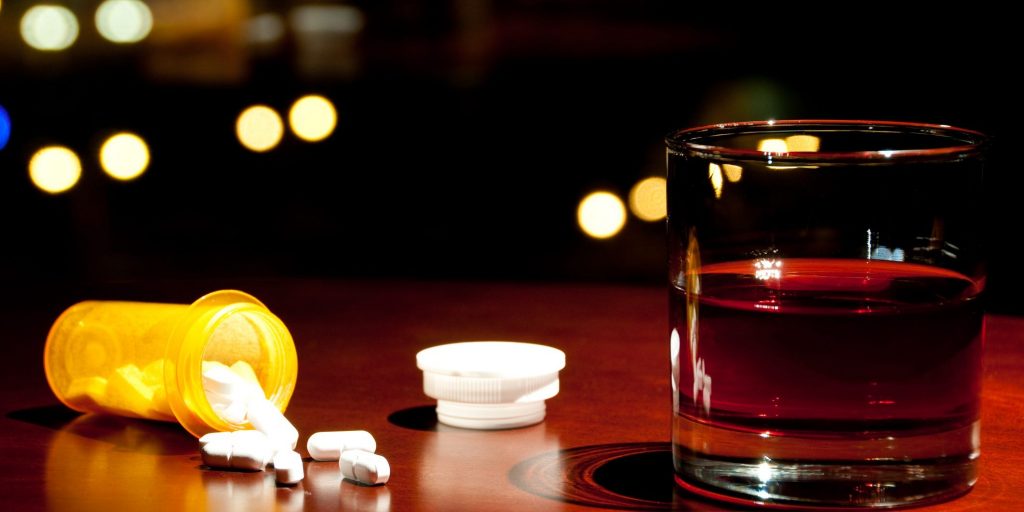- People combine alcohol and Xanax because Xanax can amplify the effect of alcohol leading to euphoria.
- But mixing the two can cause cardiac issues, breathing problems, and a lack of consciousness.
- The possibility of an overdose is also greatly increased when combining Xanax and alcohol.
Xanax and alcohol are both commonly used substances that can be safely consumed separately and within certain quantities. But mixing them can result in serious medical complications.
Xanax is the brand name for the drug alprazolam. Alprazolam is a type of benzodiazepine used to treat short-term anxiety and panic disorders. It is the most prescribed psychiatric medication in the United States. In 2013, 48 million Americans were prescribed alprazolam and the prescription rate for Xanax has been climbing at a 9% rate since 2008.
Because of Xanax's popularity and the prevalence of alcohol in American culture, it is not uncommon for people to combine Xanax and alcohol, says Joseph Volpicelli, MD, executive director of the Institute of Addiction Medicine and founder of the Volpicelli Center, an addiction recovery program.
But mixing these two substances can lead to serious complications, including risk of addiction, overdose, breathing difficulties, or death.
Why do people mix Xanax and alcohol?
Xanax requires a prescription, but it isn't uncommon for people who have not been prescribed the drug to obtain it from other people with prescriptions, says Sung Cheol "Sunny" Kim, a psychiatric mental health nurse practitioner with Confidant Health, a virtual addiction treatment program.
People combine Xanax and alcohol recreationally because:
1. It feels good: Using Xanax and alcohol simultaneously may initially decrease symptoms of anxiety and depression while increasing feelings of euphoria for the user, says Erin Hillers, a nurse practitioner and certified addiction registered nurse with Confidant Health.
However, as the alcohol wears off, anxiety can return at even higher levels, resulting in the user taking more Xanax, Volpicelli says. "Over time this can create a vicious cycle where drinking creates the need to use more Xanax, leading to addiction to Xanax, alcohol, or both."
2. To escape: Xanax can intensify the effects of alcohol, Kim says, so some people may mix the two to try to amplify how alcohol makes them feel. "Most of my patients with benzodiazepine misuse use Xanax to escape from their volatile life, uncontrolled anxiety, or inability to fall asleep," Kim says.
Some people may also be unaware of the dangerous complications of combining Xanax and alcohol and may not realize they are putting themselves at risk when taking their prescribed amount of Xanax and having a drink with dinner, Volpicelli says. But any combination of Xanax and alcohol can be dangerous and should be avoided.
What are the effects of mixing Xanax and alcohol?
Xanax and alcohol are depressants, meaning they affect the same set of receptors that help control the central nervous system, Kim says. Depressants slow down nervous system function, which can increase feelings of relaxation and sleepiness while also impairing coordination and speech.
Therefore, when combining Xanax and alcohol, these effects are amplified putting you at risk of:
- Severe drowsiness
- Muscle weakness
- Cardiac issues
- Breathing difficulties
- Loss of consciousness
- Memory impairment
One of the biggest short-term dangers of combining alcohol and Xanax is the risk of respiratory depression — a breathing disorder characterized by slow and ineffective breathing, Hillers says.
Respiratory depression (also known as hypoventilation) causes a buildup of carbon dioxide and an inadequate supply of oxygen in the lungs, which can ultimately lead to cardiac arrest, brain damage, coma, or death.
In the long-term, mixing Xanax and alcohol can increase the risk of becoming addicted to one or both substances, Volpicelli says. And because both Xanax and alcohol can cause life-threatening withdrawal symptoms, combining them is even more dangerous than taking them individually, Kim says.
Overdose is also more likely when combining Xanax and alcohol, Volpicelli says, because your body may not be able to handle both at the same time. In fact, a 2014 review found that alcohol was involved in 27% of emergency room visits due to benzodiazepine abuse and 21% of benzodiazepine drug-related deaths.
How to stop using Xanax and alcohol
Someone struggling with addiction to alcohol, Xanax, or both should seek medical help. If you don't know where to turn, you can contact the Substance Abuse Mental Health Services Administration (SAMHSA) hotline anytime day or night at 1-800-662-HELP (4357).
Suddenly stopping the use of Xanax and alcohol can be fatal and should be done under medical supervision, Hillers says.
Treatment will depend on your medical history and any underlying conditions you may have, Kim says. But in general, treatment can include:
- Detoxification, which may involve the use of anti-seizure medications and/or slowly tapering down your use of Xanax
- Treating underlying conditions, like depression and anxiety
- Mental health services and social support groups
Insider's takeaway
Xanax is a prescription medication used to treat anxiety and panic disorders. Alcohol is a recreational drug for people over the age of 21. By themselves, both substances can be safe when used in certain circumstances and in certain quantities, but when combined can cause life-threatening complications.
No amount of alcohol is considered safe to combine with Xanax and using them both at the same time can cause severe drowsiness, breathing difficulties, loss of consciousness, or even death.
If you or someone you love is struggling with dependence on Xanax, alcohol, or both, seek medical help or call the SAMHSA hotline at 1-800-662-HELP (4357).
